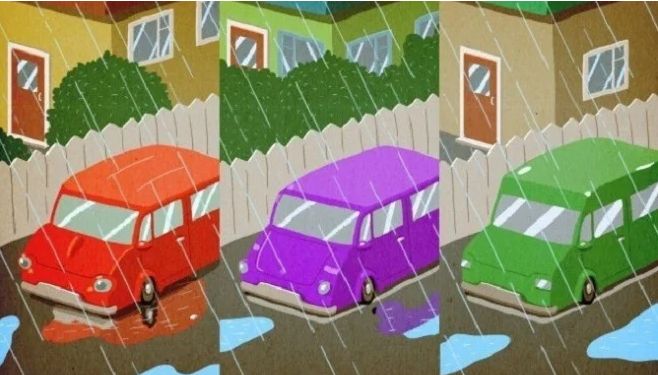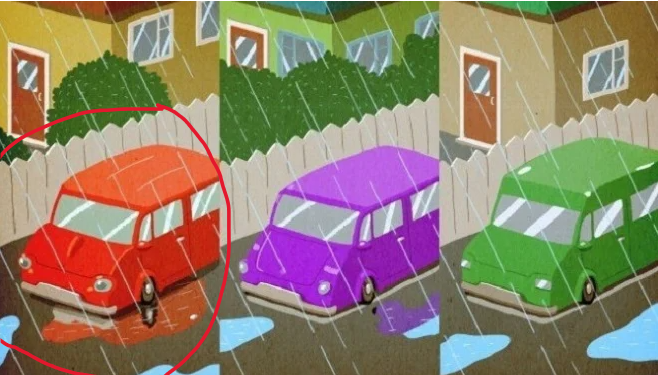Puzzles have a unique ability to captivate us, pushing our minds to unravel mysteries hidden in seemingly simple scenarios. Today, we present a challenge that will test your observational skills, logic, and attention to detail. Take a good look at the scenario described: three neighbors—each claiming to have been home during a robbery—stand as suspects. The key question is, which one of them is lying?
Common Mistakes People Make When Solving This Puzzle

At first glance, this puzzle seems straightforward. People often assume they can identify the liar by focusing solely on what appears to be the most obvious detail. However, this approach frequently leads to mistakes. Here are some common errors:
- Overlooking the Weather Condition: Many people fail to consider that it’s raining in the image and how this detail might influence the evidence presented.
- Focusing on the Cars’ Colors Alone: Some might think the colors of the cars—red, purple, and green—hold hidden meaning when, in reality, the crucial clue lies elsewhere.
- Ignoring Environmental Clues: It’s easy to overlook small but critical details, such as the presence (or absence) of water puddles beneath the vehicles.
The devil is in the details, and it’s often the smallest clues that point to the solution. This is where critical thinking and keen observation come into play.
Solving the Puzzle: A Step-by-Step Guide
Let’s break this puzzle into manageable steps and analyze the evidence carefully to pinpoint the liar.
Step 1: Analyze the Overall Setting
The first thing to notice is the environment:
- It’s raining heavily, as evidenced by the rain falling and puddles forming on the ground.
- Three cars—a red one, a purple one, and a green one—are parked in front of the houses.
- While the rain is consistent, the area around each car differs in one important way.
Step 2: Observe the Puddles Beneath the Cars
This is where the solution starts to emerge:
- The Purple Car: There is no puddle beneath the purple car. This suggests it has been parked there for a while—long enough for the rain to have washed away any sign of its arrival.
- The Green Car: Similar to the purple car, there’s no puddle beneath the green car either. This indicates that it, too, has been stationary during the rain.
- The Red Car: A distinct puddle is visible beneath the red car. This detail tells us that the red car must have arrived after the rain had started, as its movement displaced the water and created the puddle.
Step 3: Interpret the Evidence
Given these observations, we can infer:
- The purple and green cars were parked in their positions before the rain began.
- The red car, however, arrived after the rain had started. This means the owner of the red car was not at home when the rain began—contradicting their claim of being home the entire time.
Step 4: Identify the Liar
Now that we’ve analyzed the situation, it’s clear that the owner of the red car is the one lying. Their arrival during the rain exposes their false claim of having been home all along.

Why Small Details Make All the Difference
This puzzle is a fantastic example of how minor details can hold the key to solving a mystery. It highlights the importance of:
- Observing the Environment: External factors like the rain set the stage for the puzzle.
- Analyzing Contextual Clues: The puddles (or lack thereof) are subtle yet definitive indicators of the cars’ movements.
- Avoiding Assumptions: Jumping to conclusions without examining all the evidence can lead you astray.
Logical reasoning, combined with a sharp eye for detail, is what ultimately leads to the correct solution.
Final Thoughts and Call to Action
Puzzles like this one are more than just entertaining brainteasers; they’re valuable exercises in critical thinking and observation. Now that you’ve seen the solution, we’d love to hear from you:
- Did you solve the puzzle correctly on your first try?
- What clues did you focus on, and were there any you initially missed?
- Do you have a different perspective or interpretation of the evidence?
Share your answers and thoughts in the comments below! And if you enjoyed this puzzle, be sure to challenge your friends by sharing it with them.
Finally, don’t stop here! Keep sharpening your logic and reasoning skills by trying out more puzzles. The more you practice, the sharper your mind will become. Who knows? You might just become the next great detective of your circle!


